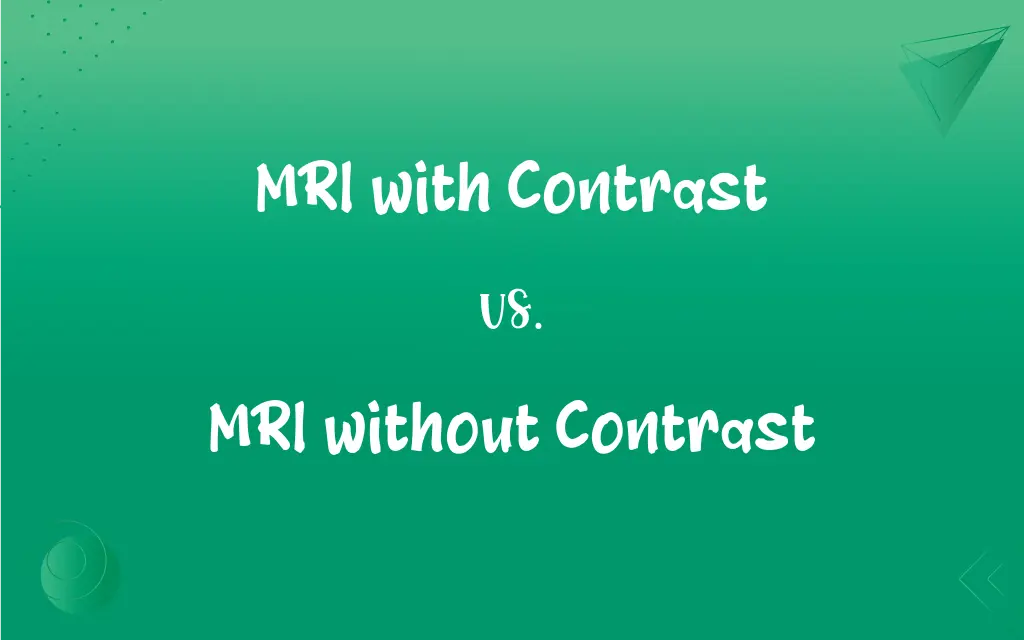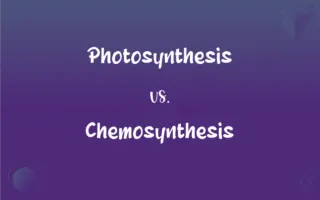MRI with Contrast vs. MRI without Contrast: What's the Difference?
Edited by Aimie Carlson || By Harlon Moss || Updated on October 8, 2023
MRI with contrast utilizes a contrast agent to enhance imaging, highlighting certain structures. MRI without contrast doesn't use a contrast agent, providing standard imaging.

Key Differences
MRI with contrast involves introducing a gadolinium-based contrast agent to visualize internal structures with greater clarity. Conversely, MRI without contrast avoids using such agents, potentially limiting the detail in imaging certain areas or pathologies.
In some clinical scenarios, MRI with contrast is imperative, such as identifying tumors, detecting vascular abnormalities, and assessing inflammatory conditions. MRI without contrast might be suitable for more general exploratory imaging or when the patient has contraindications for contrast agents.
MRI with contrast can sometimes be essential in differentiating between normal and abnormal tissues by making certain areas light up. MRI without contrast may not provide this level of detail but is useful for viewing certain types of tissues and pathologies without exposing the patient to additional substances.
Patients undergoing MRI with contrast need to be screened for kidney function due to the potential risks associated with the contrast agent. MRI without contrast, while not providing the enhanced imaging detail, doesn't pose this risk and can be used more freely among various patient populations.
The utility of MRI with contrast often hinges upon the detailed and enhanced images it can provide to ensure accurate diagnosis and management. MRI without contrast, while being broadly applicable, may be limiting in certain diagnostic contexts due to its more generalized imaging capabilities.
ADVERTISEMENT
Comparison Chart
Usage of Contrast Agent
Employs a gadolinium-based contrast agent
Does not use a contrast agent
Imaging Detail
Provides enhanced, detailed images
Provides standard imaging detail
Risk to Kidney Function
Potential risk due to contrast agent
No risk related to contrast agents
Application in Diagnosing
Essential for certain detailed diagnostic requirements
Useful for general imaging and certain diagnoses
Patient Preparation
May require additional screening and preparation
Typically requires less preparation from the patient
ADVERTISEMENT
MRI with Contrast and MRI without Contrast Definitions
MRI with Contrast
MRI with contrast is utilized to enhance the visibility of internal structures like blood vessels.
In the case of a suspected tumor, an MRI with contrast was deemed necessary.
MRI without Contrast
MRI without contrast is beneficial for routine scans where detailed imaging isn’t a necessity.
For the initial investigation into the patient's joint pain, an MRI without contrast was performed.
MRI with Contrast
MRI with contrast involves injecting a substance to illuminate certain tissues during scanning.
Her MRI with contrast showed a stark differentiation between tissues, aiding diagnosis.
MRI without Contrast
MRI without contrast is applied when a broad overview of an anatomical region is required.
The orthopedic surgeon requested an MRI without contrast to view the overall structure of the knee.
MRI with Contrast
MRI with contrast uses a gadolinium-based agent to highlight specific structures in imaging.
The doctor recommended an MRI with contrast to get a clearer image of the patient's vascular structures.
MRI without Contrast
MRI without contrast is typically used for general imaging purposes, avoiding possible contrast agent risks.
She chose an MRI without contrast to avoid potential allergic reactions to the contrast material.
MRI with Contrast
MRI with contrast aids in accurately detecting and characterizing abnormalities in the body.
MRI with contrast is often used to investigate the exact location and size of brain abnormalities.
MRI without Contrast
MRI without contrast is opted for when imaging certain tissues or structures that don’t require enhanced visibility.
MRI without contrast was deemed sufficient to monitor the size and shape of the pre-existing cyst.
MRI with Contrast
MRI with contrast can distinguish between normal and pathological tissue by enhancing visibility.
MRI with contrast was crucial in identifying the subtle vascular anomaly in the patient’s liver.
MRI without Contrast
MRI without contrast provides imaging without the use of additional enhancing agents.
Due to his compromised kidney function, the patient underwent an MRI without contrast.
FAQs
When is MRI without contrast typically used?
MRI without contrast is used when detailed, enhanced imaging isn’t necessary or when a patient has contraindications for contrast agents.
What does MRI with contrast entail?
MRI with contrast involves using a gadolinium-based contrast agent to enhance the visualization of certain body structures in the images.
Are there risks associated with MRI with contrast?
Yes, MRI with contrast can pose risks, particularly to individuals with impaired kidney function, due to the gadolinium-based contrast agent used.
How is the contrast agent administered in an MRI with contrast?
In an MRI with contrast, the contrast agent, typically gadolinium-based, is usually administered intravenously.
How quickly are results available from an MRI without contrast?
Results from an MRI without contrast may typically be available within a few days, though this can vary.
Is MRI without contrast effective for diagnosing all conditions?
No, MRI without contrast can provide excellent images but may not be as effective as MRI with contrast for detecting and characterizing certain abnormalities.
What preparation is needed for an MRI with contrast?
Preparation for an MRI with contrast might include fasting and a discussion about any allergies, kidney problems, or other health issues.
Is MRI without contrast useful for musculoskeletal issues?
Yes, MRI without contrast is commonly used for assessing musculoskeletal issues, providing detailed images of bones, joints, and soft tissues.
Can MRI without contrast detect tumors?
Yes, MRI without contrast can detect tumors, but MRI with contrast might provide clearer, more detailed images, especially for small or poorly demarcated tumors.
Is MRI without contrast safe for pregnant women?
Generally, MRI without contrast is considered safe during pregnancy, but always consult healthcare professionals before undergoing any imaging procedure.
Can MRI without contrast visualize all internal structures?
MRI without contrast can visualize many structures, but certain details, particularly vascular structures, might be better visualized with contrast.
Why is MRI with contrast preferred for certain neurological conditions?
MRI with contrast can better visualize abnormalities in the brain and spinal cord, making it preferred for certain neurological conditions to assess inflammation, tumors, and vascular issues.
What structures are typically investigated using MRI with contrast?
MRI with contrast is often used to investigate soft tissue structures, blood vessels, tumors, and areas of inflammation or infection.
Is an MRI without contrast less expensive than an MRI with contrast?
Typically, an MRI without contrast is less expensive than an MRI with contrast due to the lack of contrast agent and a simpler procedure.
Why might a doctor recommend MRI with contrast?
Doctors might recommend MRI with contrast to obtain more detailed and enhanced images, especially when evaluating blood vessels, tumors, or inflammation.
How long does an MRI with contrast procedure take?
MRI with contrast usually takes between 30 minutes to an hour, but it can vary depending on the area being imaged.
What is the risk of an allergic reaction in an MRI with contrast?
Allergic reactions to gadolinium-based contrast agents used in MRI with contrast are rare but can occur, so always inform your doctor of any known allergies or reactions.
Can MRI with contrast provide information about tissue characteristics?
Yes, MRI with contrast can provide detailed information about tissue characteristics, enhancing the differentiation between normal and abnormal tissues.
Is MRI without contrast suitable for cardiac imaging?
MRI without contrast can visualize the heart and major vessels, but MRI with contrast might be preferred for detailed evaluation of smaller vessels and cardiac tissues.
Can individuals with kidney issues have an MRI with contrast?
Individuals with kidney issues may be at risk for complications with MRI with contrast and need to discuss with healthcare professionals before the procedure.
About Author
Written by
Harlon MossHarlon is a seasoned quality moderator and accomplished content writer for Difference Wiki. An alumnus of the prestigious University of California, he earned his degree in Computer Science. Leveraging his academic background, Harlon brings a meticulous and informed perspective to his work, ensuring content accuracy and excellence.
Edited by
Aimie CarlsonAimie Carlson, holding a master's degree in English literature, is a fervent English language enthusiast. She lends her writing talents to Difference Wiki, a prominent website that specializes in comparisons, offering readers insightful analyses that both captivate and inform.
































































